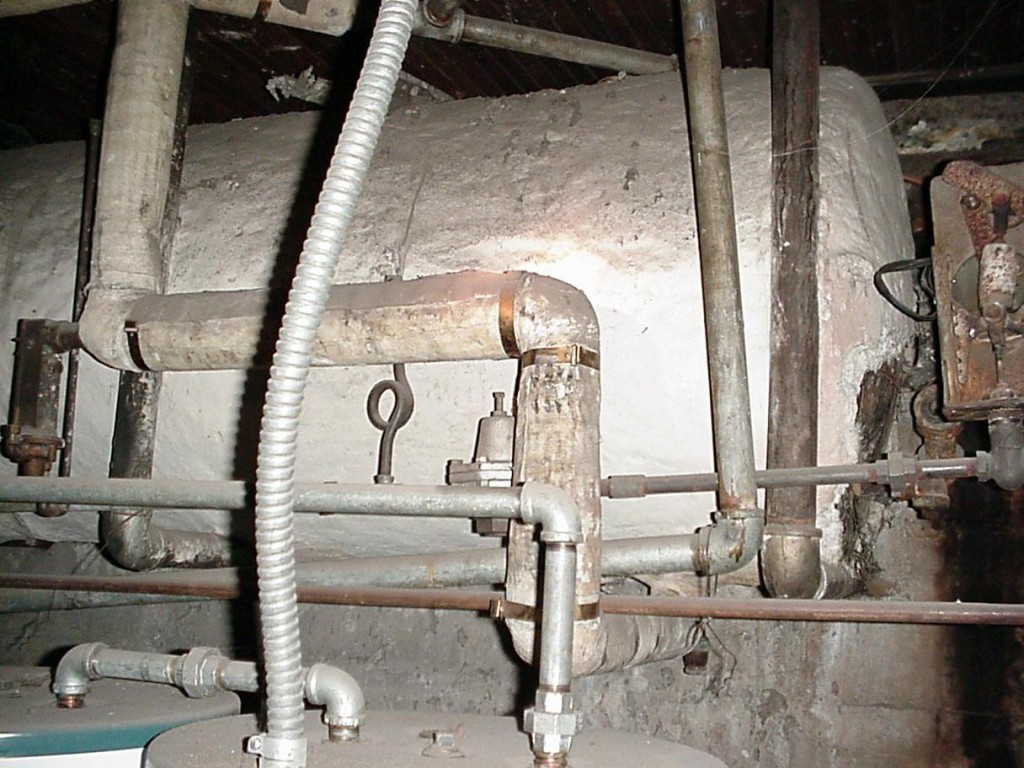Entries tagged with “OSHA”.
Did you find what you wanted?
Tue 19 Nov 2013
Posted by admin under Dust, Exposure, Federal OSHA, OSHA, PEL (Perm Exp Limit), Silica, Uncategorized
Comments Off on Silica rule delayed
For better, or worse, the silica rule has been delayed, again. This delay is for an extension of the public comment period, which goes until December 12, 2013. Public hearings are set to begin on March 4, 2014.
Find OSHA here, with links to my previous post. A NPR story from February, 2013.
My views on this rule haven’t changed much: It’s still a mixed-bag. There are still overexposures to silica (see my pictures from the last 3 weeks). However, will the new rule change the behavior?
- Overexposures are still happening
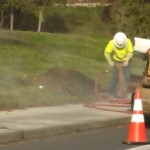
- Silica deaths have decreased over the past (without the new rule)
- Will the small employers (the ones who typically offend the most) comply? Or just wait to be cited?
But, my overwhelming thought is this:
- Any new rule will generate “noise” for the subject of silica. And, that’s a good-thing.
- This will drive:
- compliance
- changes
- innovation
- discussions
- awareness
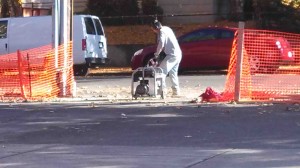
Tue 5 Nov 2013
Posted by admin under Federal OSHA, GHS, Hazard Communication, Management, MSDS, OSHA, Personal Protective Equip (PPE), Safety Programs, SDS, Training, Uncategorized
Comments Off on Hazard Communication with GHS – SDS/MSDS
If you live in the United States, you have less than one month to train your employees on the new Hazard Communication standard (1910.1200(h) & 1926.59), which should include information about the new types of Safety Data Sheets (formerly known as MSDS) and the adaptation with the Global Harmonization System (GHS). December 1, 2013 is the enforcement start date for OSHA. Don’t make this complicated, it is straightforward. Here’s what you should do:
- Train employees in hazard communication (simply: so they know the hazards they are working with)
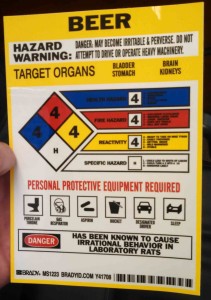
- Document your training (in case of an OSHA inspection)
- Show them a sample Safety Data Sheet (SDS), compared with the old MSDS
- Explain that the new SDS will not be available immediately, but will roll-out over a few years (or more)
*Please note the “Beer” hazard warning on the right is not GHS compliant.Â
For Help:
Fri 22 Mar 2013
It’s always fun to hear about new/different situations especially when the contractor handles it properly.
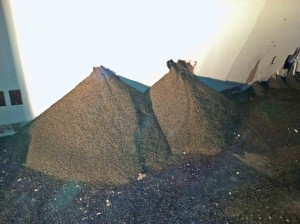
During the start of a demolition on a 1989 structure, the first swing of the hammer produced a pile of vermiculite sand.
After some discussion on “what in the world is this doing inside a wall cavity“. The contractor stopped work, had an asbestos test performed and quarantined the area. The bulk sampling for asbestos came back with the report of “asbestos containing, but less than 1%“. Well, as you know (and as I have mentioned earlier) it may not be safe to treat this product like every other demolition project. In this case, the asbestos was very friable and by opening the wall cavity, it had definitely been disturbed.  The contractor quickly set up some procedures. Here they are:
- Stop work in area. Quarantine area and place warning on doors.
- Train employees & subcontractors onsite to hazard (asbestos).
- Abatement contractor will remove wall & vermiculite
- Abatement contractor will treat the material as if it is asbestos containing
- Once the area is abated. An aggressive clearance test will be performed to assure no airborne levels of asbestos are present.
But why in the world was it in there in the first place? The best guess is it was added as a sound proofing / noise dampening for a air conditioning unit (actually a liebert unit) located on the adjacent wall. No other wall cavities contained the material.
Wed 2 Jan 2013
Posted by admin under Biological Monitoring, fit testing, Management, OSHA, Respirators, Safety Policies, Safety Programs, Training
Comments Off on Medical Questionnaire for respirators – a tip
Before you can wear a respirator here’s what has to happen:
If you’re an employer and your employees wear a respirator, they are required to have a medical approval (Appendix C of OSHA respiratory standard). more details here.
The employee fills out the confidential questionnaire and then submits it to the medical provider of the employer’s choice. 95% (I made that # up) of the time, based upon the questionnaire ONLY, they give an approval to wear a respirator.
Occasionally, some employees are requested to come into the medical office to have a spirometry test performed, which tests for lung function. (a video of how it is done, cool accent included) This tests provides more information for the physician/nurse to determine if wearing a respirator will be too difficult for an employee to wear.
The cost for either test is usually pretty close to the same price… spirometry test, or not.
Here’s my suggestion:  Have every employee perform a spirometry test before wearing a respirator. This helps to guarantee they are capable of wearing a respirator. Maybe they forgot to list a risk factor, maybe they have a hidden serious lung problem, or, maybe they lied on the questionnaire so they can wear a respirator and keep their job.?
It is also beneficial for pre-employment screening, claims defense, and for a baseline in health. The specific results are usually NOT view-able by the employer, but they can be subpoenaed.
Fri 16 Nov 2012
Posted by admin under Air Monitoring, Biological Monitoring, Dust, EPA, Federal OSHA, HEPA, Lead, OSHA, Personal Protective Equip (PPE), Respirators, Safety Programs, Training, Uncategorized
1 Comment
You must follow both. (I’ve mentioned this before)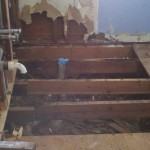
OSHA’s rules are very detailed and apply to any amount of lead in paint (even less than 0.5%) if you are disturbing it. The only time OSHA rules do not apply is:
- if you are working as a sole-proprietor (no employees), or
- if you are in some other country.
EPA’s rules are just a start. They apply to any residential facility where there are kids under the age of 6. OSHA’s rules are much more comprehensive and protective. (in some instances, overkill)
To EPA’s credit, they have done a great job of marketing and letting contractors know they insist on compliance. OSHA, on the other hand, only inspects 2% of businesses/year and does virtually no marketing. The chances of OSHA showing up on any given jobsite, is nearly 0%.
OSHA’s rules are very complete and comprehensive. You WILL need air monitoring, blood monitoring, PPE, change areas, water/sanitation, and training. The worst thing you can do is NOT follow the OSHA rules, find overexposures, and then try to “make up” for it. From my experience this scenario is a bad place to be, and happens all the time.
Wed 7 Nov 2012
The answer is Yes.
If you are working with lead (in any amount) and you are performing any of the “trigger tasks” in construction = you must follow OSHA rules. Trigger tasks are demolition, removal, encapsulation, new construction, installation, cleanup, abrasive blasting, welding, cutting, torch burning, transporting, storing, heat gun work, sanding, scraping, spray painting, burning, welding, etc. What about the EPA rules (RRP)? Look here.
The only exceptions to not measuring employees blood lead are:
- On the first day of work activity, you perform air sampling (for the full shift) and can prove the airborne levels are below the Action Limits (<30 ug/m3)…or,
- OR…If you have relevant historical data and can prove your airborne levels during the same tasks are below the Action Limit (within the last 12 months). Relevant historical data must be REALLY relevant. Like, same work activity, same amount of lead in the paint, same general size/location, etc, etc.
These are the only exceptions.
If you choose to NOT perform blood lead monitoring the downsides are:
- employees might already have dangerous levels of lead in their system, and you expose them to more
- measuring blood lead levels after the exposure may indicate higher baseline blood lead levels -and you might have to pay for exposure which wasn’t your fault
- if overexposed, and they have high blood levels – you might have to also check their family’s blood lead levels
More information on blood lead testing from my earlier post.
Wed 31 Oct 2012
Posted by admin under Admin Controls, Air Monitoring, Dust, Engineering Controls, Exposure, Federal OSHA, Hazard Communication, industrial hygienist, Management, OSHA, PEL (Perm Exp Limit), Personal Protective Equip (PPE), Safety Policies, Safety Programs, Training, TWA
Comments Off on OSHA Health Inspection – the aftermath
Background: A new client recently had an OSHA health inspection (industrial hygiene). He received citations stemming from overexposures(they found levels above the PELs) to airborne particulates.
The company wondered what to do next. Here were my suggestions:
- Fix the problem. You will need to comply and assure that your employees aren’t overexposed. Even if the inspection made you upset, use your energy to make the situation right. Focus your energy on removing the hazard, not complaining about how you were treated.
- Engineer the problem out. Remove the hazard. If not,
- Change your policies so no one is further overexposed. If you can’t fix it by the this, or the above method, then,
- Provide personal protective equipment to affected employees.
- Request the full inspection package. – this will include the officer’s field notes, interview questions, observations and sampling methodology.
- look through these documents carefully
- keep them for your records
- Â Informally appeal the citations.
- at the appeal show them you have complied/changed
- ask for a reduction in fines (it never hurts to ask)
- ask to group the citations together – instead of citation 1 item 1a, 1b, item 2, etc. ask to narrow it down to just one
- bring any additional information which supports your side and/or the changes you’ve made (including training docs, programs, policies, etc.)
- Resample the areas.
- make significant changes to these areas. Then,
- hire an industrial hygienist to perform additional sampling in these areas
- ask them to document the changes you have made to reduce the exposures
- review this with your safety committee & those affected
Wed 17 Oct 2012
Posted by admin under Admin Controls, Air Monitoring, Concrete, confined space, Engineering Controls, Exposure, Federal OSHA, fit testing, Hazard Communication, Hearing Conservation, hearing protection, Management, Noise, OSHA, Permit Required, Personal Protective Equip (PPE), Respirators, Safety Policies, Safety Programs, Silica, Training, Uncategorized, ventilation
Comments Off on Ready Mix Drum Chipping
If you operate a ready-mix plant and have concrete trucks, you are aware of this process. Once a year (hopefully, only once) a person must climb into the drum of the ready-mix truck and chip off excess concrete. What happen during regular use, is that some concrete hardens, which usually sets-up over and around the blades. Access into the drum is by either the 3×4 hole in the side, or down the chute.
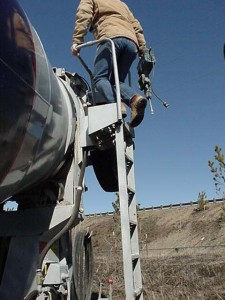
Yes, it is a confined space (def’n: 1. large enough to enter, 2. not designed for occupancy, and 3. limited entry/egress).
Here are a list of the possible hazards:
- silica dust (from chipping concrete)
- noise exposure
- hazardous atmosphere (curing concrete uses up oxygen, which we DO need BTW)
- slipping hazard (drum is round inside)
- heat stress (if you’re trying to do this activity in the summer)
- eye hazard (chipping)
- electrical hazard (if you’re using water & have an electric hammer)
- lock out / tag out (if the truck drives away, or if the barrel starts turning)
There are many resources available (see below). Some things to keep in mind; ventilation (fans, etc) to control the airborne silica dust are usually not effective (too much dust versus exhaust). Water controls are best, but you must limit the amount of water and the direction of the sprayer. I suggest looking at what others have done.
Keep in mind, if you perform this activity you will need (as a company):
- respiratory program (medical, fit test, written plan)
- confined space program (multi gas meter, written program, attendant?)
- lock out /tag out policy or procedures
- training (for each of the above, and for this specific activity)
At this point I know what my contractor-friends are thinking…I will subcontract this out!  ha. If you do, please make sure your sub is doing it right.
Resources:
Georgia Tech – good presentation & guidance
Georgia Tech/OSHA – Safe Work Practices (in Spanish too!)
Teamsters H&S hazards & controls
Illinois DCEO – Consultation on ready mix cleaning
Thu 4 Oct 2012
Posted by admin under ACGIH, Exposure, Hazard Communication, Hearing Conservation, hearing protection, Management, PEL (Perm Exp Limit), Personal Protective Equip (PPE), Safety Policies, Safety Programs, Training, TWA
Comments Off on Do we need a hearing conservation program?
Yes. If you are in construction, I recommend it. Here’s why:
First, the rules. OSHA does NOT have a specific construction standard for hearing conservation. Why does this matter? Well, the current OSHA rules state that if you have 1 day (that’s only one day) of average noise level above an average of 85 decibels A-weighted (dBA),  called the Action Limit, you are required to start a program. Obviously noise levels vary on construction jobsites. I’d guess that most projects have at least one day of levels above 85dBA’s.
called the Action Limit, you are required to start a program. Obviously noise levels vary on construction jobsites. I’d guess that most projects have at least one day of levels above 85dBA’s.
And, these particular OSHA rules are terrible. Well, they are terrible if you care about your hearing. (see my earlier post). The rules are simply not protective enough. If you are exposed to noise for 8-hours a day at 90 dBA (the OSHA average exposure limit) you WILL have hearing loss (this is without hearing protection). Does that seem like a very protective rule? Â I’ve heard talk about them changing it, but…I doubt it will ever happen.
Second, let’s consider cost vs. reward. To start a hearing conservation program you must measure your employees hearing , called audiometric testing (and do a few other things). It costs approximately $20/employee to do this per year. Compare this with the average claim (of hearing loss) cost of around $20,000. So, if you have 20 employees, and it costs you $400/year…it takes about 50 years to pay yourself back for NOT starting a program. ($20,000/400= 50 years)
Third, consider your employees. Having their hearing checked may seem like a hassle and a worthless exercise, but, some will appreciate it. I’ve found that employees like to know how they are hearing. It’s good if your employer cares how well you hear. It’s also a yearly reminder in hazard awareness to noise.
Because in construction, we know there’s noise!
If you’re dead-set on NOT having a program, you’ll need documented noise dosimetry for each employee, job task, and possible overexposure above 85 dBAs. It is possible  for a construction company to avoid having a program, but you have the burden to prove there isn’t noise. Call your favorite industrial hygienist for help.
Mon 24 Sep 2012
Posted by admin under Air Monitoring, Asbestos, Management, OSHA, Safety Programs, Training
Comments Off on I have asbestos, but it is less than 1%.
Assume your general contractor reports that he has found a material (floor tile, popcorn ceiling, etc) with less than 1%. He wants you to remove it with the rest of the demolition because, as you know, “…if it’s less than 1%, it’s NOT considered asbestos containing!”.
Are you ok to remove it?
Yes, and no. There is more to consider. The “1% rule” (as it’s called) as it is called states that they only regulate asbestos containing materials if they contain more than 1% of asbestos. Here are a few other considerations:
- OSHA definition. Don’t get stuck on the definition. If you have employees, you must still follow parts of the OSHA rules. At a minimum, you must train your employees, work practices, clean-up and disposal requirments. More details on training here.
- How were the samples taken? If one bulk sample shows less than 1% asbestos, you still might have a problem. According to the EPA/AHERA sampling rules, some types of materials must have up to 7 samples taken. This rule is in place because, back in the day, asbestos was added to joint compound (or anything similar) and it could really vary in amount according to where you take the sample. In addition, OSHA does not allow for composite sampling (combining the layers).
- Do you know that 0.99% asbestos is still bad for you? Asbestos is a carcinogen. The greater the exposure, the greater the risk of disease. Any exposure could be the one to cause the disease. If the material is friable and you are disturbing it, I would NOT recommend performing that activity. Hire an abatement contractor.
- Finally.Let’s assume it’s non-friable, you are not going to disturb it (when removing it) and it’s less than 1%. What will you do if your neighbor next door decides to call OSHA/EPA? Do you have a written plan and procedure? Have your employees been trained on the hazard? How to remove it? How to dispose of it? …Sometimes bad publicity will get you in worse trouble than any monetary fine.
 